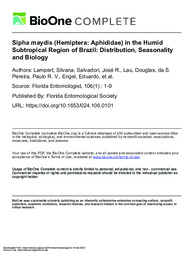Sipha maydis (Hemiptera: Aphididae) in the humid subtropical region of Brazil: distribution, seasonality and biology.
Sipha maydis (Hemiptera: Aphididae) in the humid subtropical region of Brazil: distribution, seasonality and biology.
Author(s): LAMPERT, S.; SALVADORI, J. R.; LAU, D.; PEREIRA, P. R. V. da S.; ENGEL, E.; SAVARIS, M.
Summary: Abstract: Sipha maydis (Passerini) (Hemiptera: Aphididae) is a pest of cultivated cereals and wild grasses introduced into America and first reported in South America at Argentina in 2002. In Brazil, this aphid was detected first in wheat in Oct 2006 at Rio Grande do Sul State. Between 2007 and 2013 the aphid was reported in several localities in the humid subtropical region of Brazil (southern states of Rio Grande do Sul, Santa Catarina, and Paraná) on different plant species including Triticum aestivum L., Avena strigosa Schreb., Lolium multiflorum Lam., Hordeum vulgare L., Zea mays L. (all Poaceae) and uncultivated grasses. Sipha maydis also has been captured in yellow tray traps. Peak flight activity for S. maydis occurred in the spring-summer transition and was apparently correlated with average air temperature. Sipha maydis was able to complete its life cycle on A. strigosa, L. multiflorum, H. vulgare, Z. mays, and T. aestivum. During the nymphal phase the best hosts were A. strigosa, L. multiflorum, H. vulgare, and T. aestivum. Hordeum vulgare and T. aestivum were the best for the reproductive period and longevity. The intrinsic rate of increase was greatest on A. strigosa, L. multiflorum, and T. aestivum. Generation time was longer on H. vulgare, Z. mays, and T. aestivum. Net rate reproduction was greater in H. vulgare and T. aestivum, and the finite rate of increase was greatest on A. strigosa, L. multiflorum, H. vulgare, and T. aestivum. Although the distribution of S. maydis is expanding and covering the main wheat-growing region of Brazil, and despite the wide range of hosts and the direct damage it causes to local foraging sites, aphid populations are low and their economic importance is limited. However, it reveals that S. maydis has the potential to colonize subtropical regions. Resumo: Sipha maydis (Passerini) é uma praga de cereais cultivados e gramíneas silvestres introduzida na América e relatada pela primeira vez na América do Sul na Argentina em 2002. No Brasil, o pulgão-preto-dos-cereais foi detectado pela primeira vez em Triticum aestivum L. em outubro de 2006 no Estado do Rio Grande do Sul. Entre 2007 e 2013, o pulgão foi relatado em várias localidades da região subtropical húmida do Brasil (Estados da Região Sul: Rio Grande do Sul, Santa Catarina e Paraná) em diferentes espécies de plantas como T. aestivum, Avena strigosa Schreb., Lolium multiflorum Lam., Hordeum vulgare L., Zea mays L. (todas Poaceae), e gramíneas não cultivadas. Sipha maydis também foi capturado em armadilhas do tipo bandeja amarela para pulgões alados. O pico de ocorrência das formas aladas na transição primavera-verão é aparentemente correlacionado com a temperatura média do ar. S. maydis foi capaz de completar o ciclo de vida em A. strigosa, L. multiflorum, H. vulgare, Z. mays, e T. aestivum. Durante a fase de ninfa, os melhores hospedeiros foram A. strigosa, L. multiflorum, H. vulgare, e T. aestivum. A H. vulgare e o T. aestivum foram os melhores para o período reprodutivo e longevidade. A taxa intrínseca de aumento foi grande em A. strigosa, L. multiflorum, e T. aestivum; o tempo de uma geração foi mais longo em H. vulgare, Z. mays, e T. aestivum; a taxa líquida de reprodução foi ótima em H. vulgare e em T. aestivum e a taxa de aumento finito foi grande em A. strigosa, L. multiflorum, H. vulgare, e T. aestivum. Embora a distribuição de S. maydis esteja se expandindo e cobrindo a principal região tritícola do Brasil, e a despeito da ampla gama de hospedeiros e dos danos diretos que causa aos sítios de alimentação, as populações de pulgões são baixas e sua importância econômica ainda é limitada. No entanto, revela que S. maydis tem potencial para colonizar regiões subtropicais.
Publication year: 2023
Types of publication: Journal article
Unit: Embrapa Wheat
Observation
Some of Embrapa's publications are published as ePub files. To read them, use or download one of the following free software options to your computer or mobile device. Android: Google Play Books; IOS: iBooks; Windows and Linux: Calibre.
Access other publications
Access the Agricultural Research Database (BDPA) to consult Embrapa's full library collection and records.
Visit Embrapa Bookstore to purchase books and other publications sold by Embrapa.

